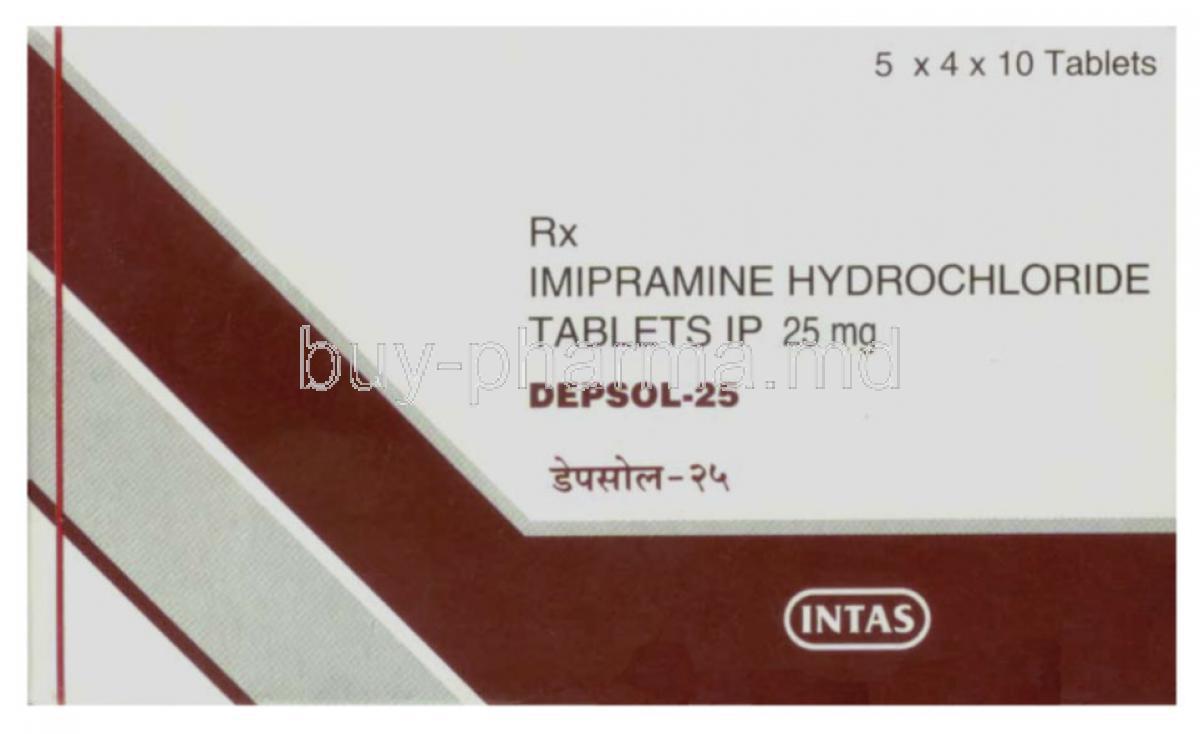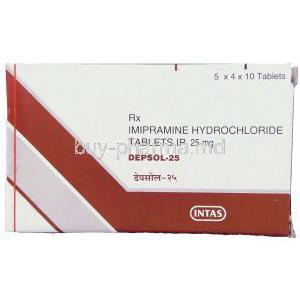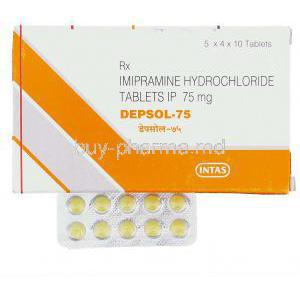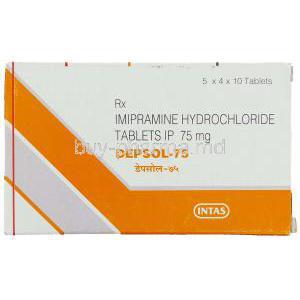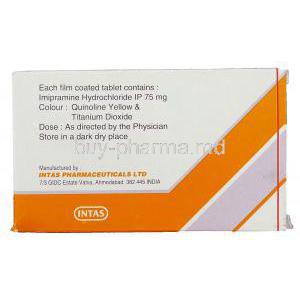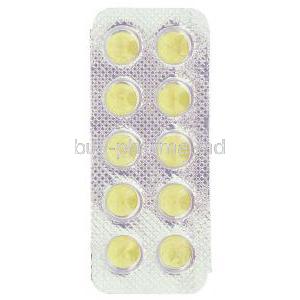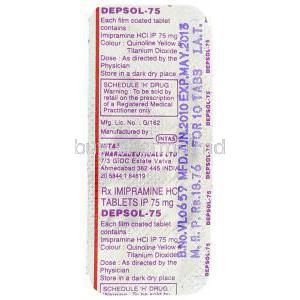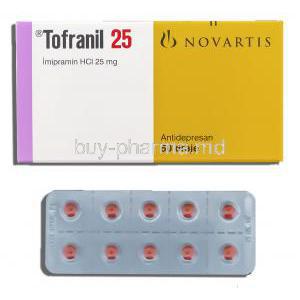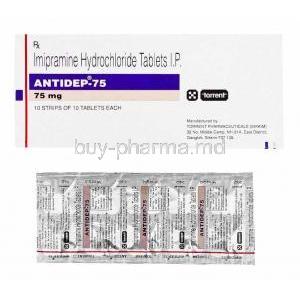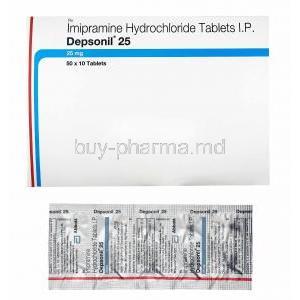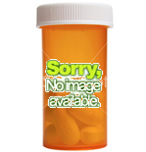1. Introduction
Depsol (Imipramine Hydrochloride) is a tricyclic antidepressant (TCA) widely prescribed for its potent effects on mood stabilization and anxiety relief. It is primarily indicated for the management of major depressive disorder (MDD), chronic anxiety, and childhood enuresis, providing therapeutic benefits through modulation of neurotransmitter pathways in the brain.
Developed in the mid-20th century, Imipramine was one of the first antidepressants to gain regulatory approval and remains a cornerstone in psychiatric pharmacotherapy. Its clinical success marked a turning point in the treatment of depression and related affective disorders, offering significant improvement in patients unresponsive to earlier sedatives or psychostimulants.
Marketed under brand names such as Depsol, Tofranil, and several generic formulations, Imipramine Hydrochloride continues to hold relevance in modern medicine. Its pharmacological profile extends beyond depression, influencing both neurological and psychosomatic conditions through complex central nervous system (CNS) activity.
- Therapeutic class: Tricyclic Antidepressant (TCA)
- Primary use: Depression, anxiety, nocturnal enuresis
- Secondary use: Chronic pain syndromes
Imipramine’s pharmacodynamic action—chiefly involving reuptake inhibition of norepinephrine and serotonin—forms the foundation of its efficacy in improving emotional equilibrium, motivation, and cognitive clarity.
2. Composition and Formulation
The active ingredient in Depsol is Imipramine Hydrochloride, a dibenzazepine derivative belonging to the tricyclic antidepressant family. Its molecular configuration enables high lipid solubility, facilitating effective blood-brain barrier penetration and CNS activity.
Depsol is available in various dosage forms to accommodate different therapeutic requirements:
- Film-coated tablets (10 mg, 25 mg, 50 mg, 75 mg)
- Capsules and oral solution for flexible dosing
- Parenteral formulations for acute or hospital-based therapy
Inactive ingredients may include lactose, starch, magnesium stearate, and colorants, depending on manufacturer specifications. The drug exhibits efficient gastrointestinal absorption, with peak plasma concentrations achieved within 2–4 hours. Metabolism primarily occurs in the liver via CYP2D6 pathways, producing active metabolites such as desipramine. The average elimination half-life ranges from 8 to 20 hours, allowing once or twice daily dosing regimens.
3. Mechanism of Action
Imipramine Hydrochloride acts by inhibiting the presynaptic reuptake of norepinephrine (NE) and serotonin (5-HT), thereby enhancing their synaptic availability and neurotransmission efficiency. This dual reuptake inhibition restores balance in neurochemical signaling networks responsible for mood, energy, and emotional stability.
- Noradrenergic effects: Promote alertness, motivation, and psychomotor activity.
- Serotonergic effects: Enhance mood, reduce anxiety, and improve sleep continuity.
Additionally, Imipramine exhibits affinity for muscarinic cholinergic, histaminergic (H1), and alpha-adrenergic receptors, explaining its sedative and anticholinergic properties. Compared with newer antidepressants, TCAs like Imipramine demonstrate broader receptor binding, resulting in both therapeutic benefits and potential side effects. Its neurotropic effects contribute to improved REM sleep regulation and reduced recurrence of depressive episodes.
4. Approved Medical Uses
- Major Depressive Disorder (MDD): Effective for endogenous and psychogenic depression, improving mood, motivation, and overall functioning.
- Anxiety and Panic Disorders: Reduces somatic anxiety symptoms, panic attacks, and chronic nervous tension.
- Nocturnal Enuresis (Children): Modulates bladder control and sleep patterns, reducing bedwetting frequency.
- Chronic Neuropathic Pain: Provides analgesic support in conditions such as diabetic neuropathy and fibromyalgia.
Imipramine remains a vital option where other antidepressant classes have proven ineffective or poorly tolerated.
5. Off-Label and Investigational Uses
Beyond its approved indications, Depsol is used off-label for a spectrum of psychiatric and neurological conditions:
- ADHD: Improves concentration and impulsivity in selected patients.
- PTSD: Alleviates intrusive thoughts, nightmares, and anxiety.
- Irritable Bowel Syndrome (IBS): Eases visceral hypersensitivity and anxiety-driven symptoms.
- Migraine and Tension Headaches: Acts as a preventive therapy by stabilizing neural excitability.
- Sleep Disorders: Enhances sleep continuity in insomnia and trauma-related nightmares.
- Premature Ejaculation: Delays orgasm through serotonergic modulation.
- Chronic Fatigue and Pain Syndromes: Reduces fatigue and central pain sensitization.
6. Dosage and Administration
Dosage must be individualized according to diagnosis and patient tolerance.
- Adults (Depression): Initial dose 25–50 mg daily, increased gradually to 150–200 mg/day in divided doses.
- Children (Enuresis): 10–25 mg at bedtime, titrated by response and age.
- Neuropathic Pain: Typically 25–75 mg daily, adjusted by clinical effect.
Tablets are administered orally, preferably at bedtime to minimize daytime drowsiness. Discontinuation must be gradual to prevent withdrawal symptoms such as irritability, headache, or sleep disturbances. When switching from another antidepressant, appropriate washout periods should be observed.
7. Warnings and Important Precautions
- Suicidality: Increased risk in adolescents and young adults during early therapy phases.
- Cardiac Toxicity: QT prolongation and arrhythmia risk, particularly in overdose or pre-existing cardiac disease.
- Orthostatic Hypotension: May cause dizziness upon standing; slow positional changes advised.
- Anticholinergic Effects: Dry mouth, constipation, urinary retention, and blurred vision may occur.
- CNS Depression: Sedation and cognitive dulling possible; avoid alcohol and sedatives.
- Organ Impairment: Adjust dose in hepatic or renal dysfunction.
Patients should be advised to report any unusual mood changes, cardiac symptoms, or visual disturbances promptly.
8. Contraindications
- Known hypersensitivity to Imipramine or related tricyclic compounds
- Concurrent or recent (<14 days) use of MAO inhibitors
- Acute myocardial infarction or severe cardiac arrhythmia
- Severe hepatic or renal insufficiency
- Narrow-angle glaucoma or urinary retention
- Untreated bipolar mania or hyperthyroidism
9. Careful Administration and Monitoring
Clinical monitoring enhances both safety and therapeutic outcomes:
- Obtain baseline ECG and blood pressure readings before initiation in adults.
- Conduct periodic liver and renal function tests during long-term therapy.
- Exercise caution in patients with seizure disorders or endocrine imbalance.
- Observe for mood elevation or hypomania in bipolar individuals.
- Adjust dosage in hepatic or renal impairment to prevent accumulation.
- Avoid abrupt cessation to minimize discontinuation syndrome.
With prudent monitoring and individualized management, Depsol can offer durable symptom control and functional recovery in diverse psychiatric and somatic conditions.
10. Adverse Reactions and Side Effects
10.1 Common Side Effects
Depsol (Imipramine Hydrochloride) can produce several mild to moderate side effects, particularly during the initiation of therapy. Most of these reactions diminish as the body adapts to the medication’s pharmacologic effects.
- Drowsiness, Dizziness, or Fatigue: Mild central nervous system depression may occur, especially in the early stages of treatment. Caution is advised when engaging in activities requiring alertness.
- Dry Mouth, Blurred Vision, and Constipation: Anticholinergic activity may cause reduced salivation, visual accommodation difficulty, and delayed gastrointestinal motility.
- Nausea, Vomiting, or Appetite Changes: Gastrointestinal irritation can result in altered appetite or mild dyspepsia.
- Weight Gain and Sweating: Metabolic alterations and sympathetic stimulation may contribute to gradual weight increase and increased perspiration.
- Mild Hypotension or Tachycardia: Cardiovascular adaptations to noradrenergic modulation may transiently alter blood pressure and heart rate.
10.2 Serious and Rare Side Effects
Although uncommon, serious adverse effects may occur, particularly at high doses or in susceptible individuals. Immediate medical evaluation is warranted if these symptoms arise.
- Cardiac Arrhythmias and ECG Changes: Imipramine can prolong conduction intervals and precipitate rhythm disturbances, especially in overdose.
- Seizures or Serotonin Syndrome: Excess serotonergic activity may result in hyperthermia, tremors, and altered mental status.
- Hepatotoxicity and Jaundice: Rare hepatic injury may manifest through elevated liver enzymes or yellowing of the skin and sclera.
- Blood Dyscrasias: Conditions such as leukopenia or agranulocytosis can increase infection susceptibility.
- Allergic Skin Reactions and Photosensitivity: Rashes, urticaria, or heightened sensitivity to sunlight may develop in hypersensitive individuals.
- Urinary Retention or Sexual Dysfunction: Anticholinergic and adrenergic receptor blockade may lead to voiding difficulty or libido alteration.
11. Drug Interactions
Imipramine Hydrochloride interacts with a range of pharmacologic agents. These interactions can amplify therapeutic effects or precipitate toxic reactions.
- MAO Inhibitors: Concurrent use may cause hypertensive crisis or hyperpyrexia; a 14-day washout period is mandatory.
- SSRIs: Risk of serotonin syndrome increases with combined serotonergic therapy.
- Alcohol, Benzodiazepines, and Sedatives: Additive CNS depression may impair psychomotor function.
- CYP450 Enzyme Modulators: Inhibitors like cimetidine or fluoxetine increase plasma concentrations; inducers like carbamazepine reduce efficacy.
- Anticholinergics and Antihypertensives: Additive side effects such as constipation or hypotension can occur.
- Thyroid Hormones and Antiarrhythmics: May potentiate cardiac toxicity and arrhythmogenic risk.
12. Administration in Special Populations
12.1 Elderly Patients
Older adults exhibit diminished hepatic metabolism and renal clearance, leading to elevated plasma levels. This increases sensitivity to sedative and cardiovascular effects.
- Start with the lowest effective dose and titrate gradually.
- Monitor for orthostatic hypotension, confusion, and falls.
- Regular ECG assessment is recommended for long-term therapy.
12.2 Pregnant Women and Nursing Mothers
Imipramine crosses the placental barrier and is excreted in breast milk, posing potential risks to the fetus or neonate.
- Use during pregnancy only if the potential therapeutic benefit outweighs fetal risk.
- Newborns may exhibit withdrawal symptoms such as irritability or tremors.
- Nursing infants should be monitored for sedation and feeding difficulties.
12.3 Pediatric Use
Depsol is approved for the treatment of nocturnal enuresis in children but requires caution in psychiatric use.
- Dosage must not exceed recommended pediatric limits.
- In depression, heightened monitoring for suicidal ideation is essential.
- Adolescent patients require close supervision during dose initiation and adjustment.
13. Overdosage and Toxicity Management
Overdose with Imipramine is a medical emergency characterized by severe cardiotoxicity and neurotoxicity.
- Clinical Signs: Confusion, seizures, hypotension, cardiac arrhythmias, respiratory depression, or coma.
- Emergency Measures: Immediate gastric lavage, administration of activated charcoal, and supportive airway management.
- Monitoring: Continuous ECG and vital sign monitoring until clinical stability is achieved.
- Corrective Therapy: Sodium bicarbonate to counteract cardiac conduction disturbances; physostigmine in severe anticholinergic toxicity.
14. Handling and Storage Precautions
- Store at controlled room temperature, ideally between 20°C and 25°C.
- Protect from light, heat, and excessive humidity.
- Keep tightly closed and out of reach of children and animals.
- Dispose of expired medication through approved pharmaceutical disposal systems.
15. Patient Counseling and Education
Patient awareness and compliance significantly influence therapeutic success and safety.
- Emphasize strict adherence to prescribed dosage and schedule.
- Avoid concurrent alcohol consumption and sedative agents.
- Advise caution when operating machinery or driving due to possible drowsiness.
- Educate on recognizing early side effects such as palpitations, confusion, or jaundice.
- Stress the need for gradual discontinuation under medical supervision to avoid withdrawal symptoms.
16. Summary
Depsol (Imipramine Hydrochloride) remains a valuable pharmacologic tool for managing depression, anxiety, and certain somatic disorders. Its broad receptor profile enables robust therapeutic efficacy but necessitates careful dosing and monitoring. Compared to newer antidepressants, its efficacy endures, though side effect management is more complex.
When administered under medical supervision, Imipramine can markedly enhance quality of life, mood stability, and sleep architecture. Individualized treatment strategies, combined with vigilance for adverse reactions, ensure optimal outcomes in both psychiatric and neurologic applications.

